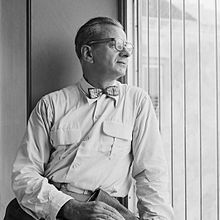| Charles Eyck | |
|---|---|
 Eyck in 1953 Eyck in 1953 | |
| Born | (1897-03-24)24 March 1897 Meerssen, Limburg, Netherlands |
| Died | 2 August 1983(1983-08-02) (aged 86) Schimmert, Limburg, Netherlands |
| Nationality | Dutch |
| Education | Rijksakademie van beeldende kunsten in Amsterdam |
| Known for | Painting |
| Movement | Expressionism |
Charles Hubert Eyck (24 March 1897 – 2 August 1983) was a Dutch visual artist. Together with Henri Jonas [nl] and Joep Nicolas, he was a pioneer of the Limburg School [nl].
Life and work


Charles Eyck was born in 1897 in Meerssen. He received his training at the Rijksacademie in Amsterdam. He had previously started as a pottery painter at the ceramics factory Céramique in Maastricht. In 1922, he won the Prix de Rome. After short stays in Sweden, Curaçao, southern France, Amsterdam, Clamart and Utrecht, he settled in Schimmert.
Initially, his work was expressionistic in style. He was later criticized for persisting in a more or less consistent religious style. Partly because of these criticisms and his increasing deafness, he lived more and more in seclusion in the house "Ravensbos" in Schimmert, which he designed himself.
After the unveiling of the Bevrijdingsraam in the Sint Janskerk in Gouda (1947), Eyck was presented with the decoration of a Knight in the Order of Orange-Nassau. He returned the award almost twenty years later, because he could not agree with a marriage between Princess Beatrix and the German Claus.
Charles Eyck died at the age of 86.
Works
- Begraafplaats van Aubel (1920), funerary chapel in Meerssen
- Fresco (1937) in the refectory of the Klooster Mariënhage in Eindhoven
- Het Verkeer (1939), design, in the context of 100 years of Dutch railways, executed by Jo Uiterwaal, Utrecht
- Polyptiek (1941) in the Onze Lieve Vrouw van Goede Raadkerk in Beverwijk
- Windows (1945) of the city hall of Uithuizermeeden
- Stations of the Cross (1946) in the Sint-Franciscuskerk in Groningen
- Bevrijdingsraam (1947) in the Sint Janskerk of Gouda
- The official investiture painting (1948) of Queen Juliana
- Stained glass windows (1948/1950) in the Sint-Catharinakerk in Eindhoven
- Limburgs bevrijdingsmonument (1952) on the Koningsplein in Maastricht
- Wall painting (1953) in the officers' mess of the R.K. Zeemanshuis in Willemstad, Curaçao
- Tile panel (1954) of Elizabeth of Hungary on the back facade of the former Sint-Elisabeth Hospital in Willemstad, Curaçao
- Uniforms (1957) Schuttersgezelschap Sint Sebastiaan Schimmert
- Paintings and stained glass windows (1958) for the Jozef Arbeiderkerk in Meerssen
- Wall paintings (1962) in the church of Jeantes (Picardy)
- Altar wall and Stations of the Cross in Zeist
- Windows in the Roman Catholic HBS in Heerlen
- 24 stained glass windows in the Sint Jozef kerk of Achterveld
- Stained glass windows in the Sint Martinuskerk in Venlo
- Stations of the Cross in Enschede, in the Koepelkerk in Maastricht and in Schijndel
- Stations of the Cross in Sint-Jan de Doperkerk in Waalwijk (1940-1943): due to Van Eyck's refusal to join the Kultuurkamer established by the German occupier, 3 of the 14 stations are not polychromed but still in the original terracotta colour
- Stations of the Cross in de Sint-Martinuskerk in Genk
- The painting of the vault and the apse in the St. Hubertuskerk in Genhout (municipality of Beek)
- Paintings in the Onze Lieve Vrouwe Kerk in Helmond, assisted by Daan Wildschut and Ries Mulder
- Paintings in the house at the Warandelaan in Helmond
- Church painting in the church of the Redemptoristenklooster in Wittem
- Church painting in the Sint-Barbarakerk in Bunnik
- Stained glass window in the former Chamber of Commerce of Venlo
- Illustrations for Karel en Elegast, by Jef Spuisers
- Stained glass windows in the Sint-Gerardus Majellakerk in Nederweert-Eind
- Apse of the Sint-Gerardus Majellakerk in Heksenberg-Heerlen
- Stained glass window in the former town hall of Hoensbroek
- Wall painting in the H. Andreas en Antoniuskerk in Oostelbeers
References
- Muurvast & Gebeiteld - Beeldhouwkunst in de bouw 1840 - 1940, Ype Koopmans, 1997 NAi Uitgevers ISBN 9056620762
- ^ Jonkergouw, A.E.L. (1993). Historisch Jaarboek voor het Land van Zwentibold - 1993 (in Dutch). Stichting Historisch Jaarboek voor het Land van Zwentibold. p. 114. Retrieved 13 June 2022.
- Tegeltableau van Charles Eyck in rubberfabriek Ceylon in Maastricht teruggevonden. NOS 7 November 2021
- "CHARLES EYCK stuurt onderscheiding terug Protest legen huwelijk Beatrix", Amigoe di Curaçao, 5 februari 1966; "Schilder zendt „lintje” terug", Friese koerier, 7 February 1966.
- Centraal Museum (Utrecht, Netherlands) (2009). Zijlmans, Kitty; Knol, Meta; Raben, Remco (eds.). Beyond the Dutch Indonesia, the Netherlands, and the Visual Arts from 1900 Until Now. KIT Publishers. p. 107. ISBN 9789460220593. Retrieved 13 June 2022.
- "Charles Eyck schiep kunstwerk voor R.K. Zeemanshuis". Amigoe. 10 April 1953. Retrieved 10 November 2021.
- "Charles Eyck voltooit tegelpaneel voor Elisabeth ziekenhuis". Amigoe. 31 July 1954. Retrieved 10 November 2021.
External links
![]() Media related to Charles Eyck at Wikimedia Commons
Media related to Charles Eyck at Wikimedia Commons